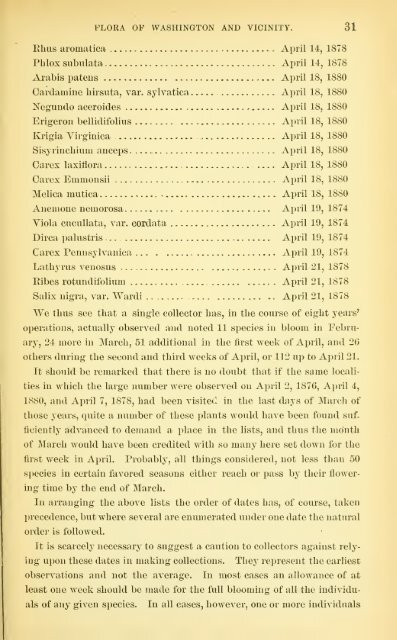Bulletin - United States National Museum - Smithsonian Institution
Bulletin - United States National Museum - Smithsonian Institution
Bulletin - United States National Museum - Smithsonian Institution
You also want an ePaper? Increase the reach of your titles
YUMPU automatically turns print PDFs into web optimized ePapers that Google loves.
FLORA OF WASHINGTON AND VICINITY. 31<br />
Ehus aromatica April 14, 1878<br />
Phlox subulata April 14, 1878<br />
Arabis patens April 18, 1880<br />
Cardamine liirsuta, var. sylvatica April 18, 1880<br />
Negundo aceroides April 18, 1880<br />
Erigeron bellidifolius April 18, 1880<br />
Krigia Virginica Ajiril 18, 1880<br />
Sisyrinchium anceps April 18, 1880<br />
Carex laxiflora April 18, 1880<br />
Carex Emmonsii April 18, 1880<br />
Melica mutica April 18, 1880<br />
Aueinone nemorosa April 19, 1874<br />
Viola cucullata, var. cordata Aj)ril 19, 1874<br />
Dirca palustris — April 19, 1874<br />
Carex Penusylvauica April 19, 1874<br />
Lathyrus veuosus April 21, 1878<br />
Kibes rotundifoliuni April 21, 1878<br />
Salix nigra, var. Wardi . . April 21, 1878<br />
We thus see that a single collector has, in the course of eight years^<br />
operations, actually observed and noted 11 species in bloom in Febru-<br />
ary, 24 more in March, 51 additional in the first week of Ai)ril, and 26<br />
others during the second and third weeks of April, or 112 up to April 21.<br />
It should be remarked that there is no doubt tliat if the same locali-<br />
ties in which the large number were observed on April 2, 187C, April 4,<br />
1880, and April 7, 1878, had been visited in the last days of March of<br />
those years, quite a number of these plants would have been found suf-<br />
ficiently advanced to demand a place in the lists, and thus the month<br />
of March would have been credited with so many here set down for the<br />
first week in April. Probably, all things considered, not less than 50<br />
species in certain favored seasons either reach or pass by their flower-<br />
ing time by the end of March.<br />
In arranging the above lists the order of dates has, of course, taken<br />
precedence, but where se\'eral are enumerated under one date the natural<br />
order is followed.<br />
It is scarcely necessary to suggest a caution to collectors against rely-<br />
ing upon these dates in making collections. They represent the earliest<br />
observations and not the average. In most cases an allowance of at<br />
least one week should be made for the full blooming of all the individu-<br />
als of any given species. In all cases, however, one or more individuals

















